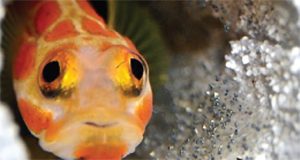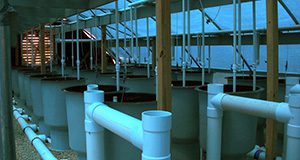Marine ornamental fish production is still in its infancy compared with its freshwater counterpart. About 1,800 wild-caught fish species are imported into the United States each year, clear proof of the need for the expansion of marine ornamental production to include new species and families of fish. Distinct behavior and a wide range of colors makes fish from the Blenniidae family, called blennies, a popular choice in the aquarium hobby. These hardy fish are small and rarely aggressive to other reef species and they eat algae and clean tank substrate. This 6-page fact sheet written by Jesse Von Linden, Joshua T. Patterson, Cortney L. Ohs, and Matthew A. DiMaggio and published by the UF/IFAS Program in Fisheries and Aquatic Sciences, School of Forest Resources and Conservation provides a brief overview of the family including description and taxonomy, natural history, culture techniques, a bit about disease challenges, and advice on marketing for ornamental Blennids.
https://edis.ifas.ufl.edu/fa225
Tag: Matthew A. DiMaggio
Aquaculture Applications of the Family Gobiidae
Marine ornamental fish production is still in its infancy compared with its freshwater counterpart. About 1,800 wild-caught fish species are imported into the United States each year, clear proof of the need for the expansion of marine ornamental production to include new species and families of fish. The family Gobiidae is the fourth most imported family of marine ornamental fish. Gobies can be easily housed with a variety of other species of fish. Several have qualities that lend themselves to aquarium life. Some clean other fish and others sift the sand bed. Many naturally perch on the rockscape or corals, spending their time beautifying their surroundings with their bright colors and intriguing behavior. This 7-page fact sheet written by Jesse Von Linden, Joshua T. Patterson, Cortney L. Ohs, and Matthew A. DiMaggio and published by the UF/IFAS Program in Fisheries and Aquatic Sciences, School of Forest Resources and Conservation provides a brief overview of the family including description and taxonomy, natural history, culture techniques, a bit about disease challenges, and advice on marketing for ornamental Gobids.
https://edis.ifas.ufl.edu/fa226
Overview of Commonly Cultured Marine Ornamental Fish
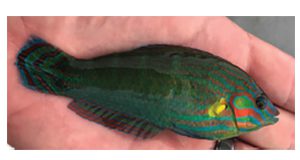
The production of freshwater ornamental fish dominates the ornamental aquaculture industry, yet the small marine ornamentals sector has grown substantially in recent years. This 7-page fact sheet written by Elizabeth M. Groover, Matthew A. DiMaggio, and Eric J. Cassiano and published by the UF/IFAS Program in Fisheries and Aquatic Sciences, School of Forest Resources and Conservation briefly reviews the more common groups of marine ornamental fishes cultured in the United States. As we learn more about marine ornamentals and as aquaculture protocols for marine ornamentals develop and improve, it is possible that more species may become economically feasible to produce and more cultured marine fish may begin to supplement wild-caught stocks in the marine aquarium trade.
https://edis.ifas.ufl.edu/fa224
Overview of Urban Aquaculture
This 6-page fact sheet written by Emily H. Roan, Laura Tiu, Roy P.E. Yanong, Matthew A. DiMaggio, and Joshua T. Patterson and published by the UF/IFAS Program in Fisheries and Aquatic Sciences, School of Forest Resources and Conservation provides introductory information for people interested in engaging in commercial or hobby-scale aquaculture in urban or suburban areas. It introduces three common types of urban aquaculture systems, describes the resources and challenges unique to urban aquaculture, and includes a handy “getting started” section.
http://edis.ifas.ufl.edu/fa217
Microworm Culture for Use in Freshwater Ornamental Aquaculture

A small nematode worm commonly referred to as a “microworm” has been a staple live feed used in the ornamental aquaculture industry for over 50 years. These worms are small enough to be ingested by the larvae of many commonly cultured ornamental species, and their production methods are simple and reliable. Microworms have the potential to provide appropriate nutrition in a live feed organism that is cultured entirely in-house and involves less labor and cost than newly hatched Artemia. In this 4-page fact sheet published by the UF/IFAS School of Forest Resources and Conservation, Program in Fisheries and Aquatic Sciences, authors Shane W. Ramee, Taylor N. Lipscomb, and Matthew A. DiMaggio discuss the biology, environmental requirements, and culture techniques for microworms and explain their importance for the larval culture of freshwater fish species.
http://edis.ifas.ufl.edu/fa214
Candidate Species for Florida Aquaculture: Gulf Killifish, Fundulus grandis
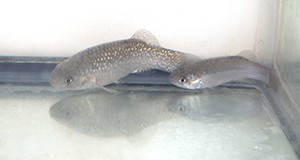
The Gulf killifish is a promising species for commercial aquaculture in Florida with the potential to help diversify the marine baitfish aquaculture industry in Florida and throughout the southeastern United States. Methods for culturing this species have improved in the past decade; this 6-page fact sheet describes the new methods and some strategies to give producers greater control of reproduction, larval growth, and survival. The publication provides the information producers need to make the most informed decision possible when considering Gulf killifish aquaculture. Written by Shane W. Ramee, Joshua T. Patterson, Cortney L. Ohs, and Matthew A. DiMaggio and published by the Program in Fisheries and Aquatic Sciences, School of Forest Resources and Conservation.
http://edis.ifas.ufl.edu/fa190
Using Airlifts to Collect and Concentrate Copepod Nauplii
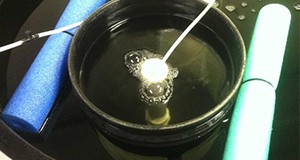
Airlifts are simple and inexpensive and not new to aquaculture. The buoyancy of rising bubbles within a pipe or tube generates an upward flow of water that are often used as part of water treatment design in recirculating aquaculture systems, but can also be used to collect and concentrate live food organisms fed to marine fish larvae. Airlifts are more gentle and efficient than sieving. This 3-page fact sheet provides protocols and designs for harvesting and feeding copepod nauplii to marine fish larvae, but these methods can be adapted for use with many live feed organisms. Written by Eric Cassiano, Matthew DiMaggio, Cortney Ohs, and John Marcellus, and published by the UF Department of Fisheries and Aquatic Sciences, May 2015. (Photo credit: Jason S. Broach)
http://edis.ifas.ufl.edu/fa188
FA168 Candidate Species for Florida Aquaculture: Pinfish, Lagodon rhomboides
FA168, a 6-page illustrated fact sheet by Cortney L. Ohs, Scott W. Grabe, Matthew A. DiMaggio, describes this marine baitfish of the Sparidae (porgy/sea bream) family which has potential for culture in the southeastern United States — general description, geographic distribution and habitat, nautral history, culture techniques, broodstock nutrition, broodstock reproduction, hatchery, nursery, growout, disease, and market. Includes references. Published by the UF Program in Fisheries and Aquatic Sciences, School of Forest Resources and Conservation, May 2010.
http://edis.ifas.ufl.edu/fa168

